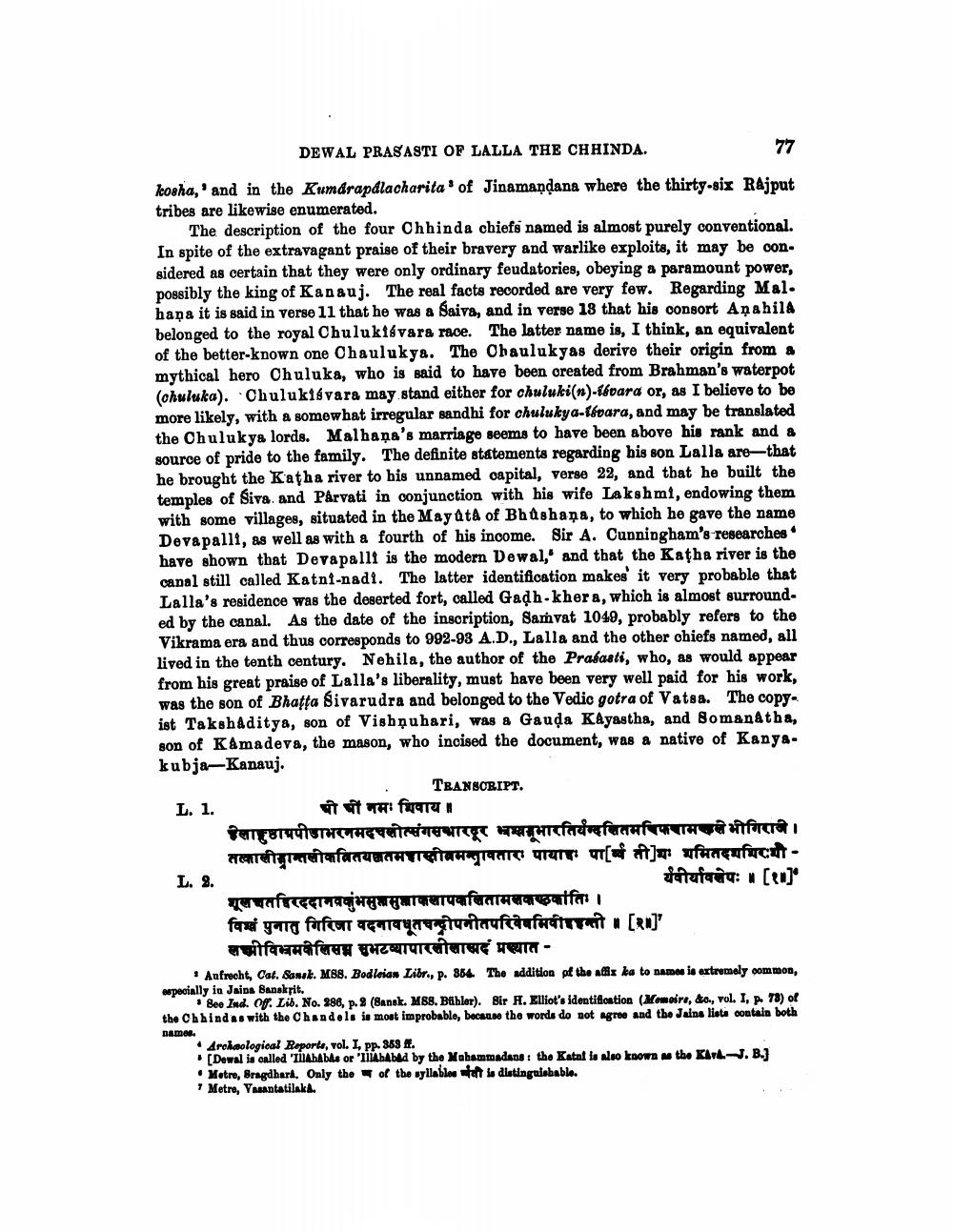________________
DEWAL PRASASTI OF LALLA THE CHHINDA.
hosha, and in the Kumárapdlacharita' of Jinamandana where the thirty-six Rajput tribes are likewise enumerated.
The description of the four Chhinda chiefs named is almost purely conventional. In spite of the extravagant praise of their bravery and warlike exploits, it may be considered as certain that they were only ordinary feudatories, obeying a paramount power, possibly the king of Kanauj. The real facts recorded are very few. Regarding Malhapa it is said in verse 11 that he was a Saiva, and in verse 13 that his consort Anahila belonged to the royal Chulukisvara race. The latter name is, I think, an equivalent of the better-known one Chaulukys. The Chaulukyas derive their origin from a mythical hero Chuluka, who is said to have been created from Brahman's waterpot (chuluka). Chulukisvara may stand either for chuluki(n)-isvara or, as I believe to be more likely, with a somewhat irregular sandhi for chulukya-tévara, and may be translated the Chulukya lords. Malhana's marriage seems to have been above his rank and a source of pride to the family. The definite statements regarding his son Lalla are-that he brought the Katha river to his unnamed capital, verse 22, and that he built the temples of Siva. and Pârvati in conjunction with his wife Lakshmi, endowing them with some villages, situated in the Mayata of Bhushana, to which he gave the name Devapalli, as well as with a fourth of his income. Sir A. Cunningham's researches. have shown that Devapalli is the modern Dewal, and that the Katha river is the canal still called Katni-nadi. The latter identification makes it very probable that Lalla's residence was the deserted fort, called Gadh-khera, which is almost surrounded by the canal. As the date of the inscription, Samvat 1049, probably refers to the Vikrama era and thus corresponds to 992-93 A.D., Lalla and the other chiefs named, all lived in the tenth century. Nehila, the author of the Prasasti, who, as would appear from his great praise of Lalla's liberality, must have been very well paid for his work, was the son of Bhatta Sivarudra and belonged to the Vedic gotra of Vatsa. The copyist Takshaditya, son of Vishnu hari, was a Gauda Kayastha, and Somanatha, son of Kamadeva, the mason, who incised the document, was a native of Kanyakubja-Kanauj.
L. 1.
L. 2.
TRANSCRIPT.
यो म नमः शिवाय ॥
Bangarudiathema¶ntedwuwrege murgunefinde fenfew तत्कालीग्रामासीकत्रितयज्ञतमासीनमन्ायतारा पाया पार्थ मी)
77
शूल चतहिरददानवकुंभमुक्तमुक्ता कलापकलितामलकण्ठकांतिः । fani yang faftur qarayaugtudtaufchrufirituwait • [10]" wwiftam feux yuzaturcituraÉ HONA -
mapit sirfærerët i ममितदममिरचीefterfacia: [en]*
Aufrecht, Cat. Sanak. MSS. Bodleian Libr., p. 354. The addition of the affix ka to names is extremely common, especially in Jaina Sanskrit.
Bee Ind. Off. Lib. No. 286, p. 2 (Sansk. MSS. Bühler). Sir H. Elliot's identification (Memoire, &c., vol. I, p. 78) of the Chhindas with the Chandels is most improbable, because the words do not agree and the Jains lists contain both
names.
Archaeological Reports, vol. I, pp. 353 ff.
[Dewal is called 'Tilahabas or 'Illahabad by the Mahammadans: the Katni is also known as the Kava.-J. B.] Metre, Bragdhara. Only the of the syllables weft is distinguishable.
7 Metre, Vasantatilaka.




